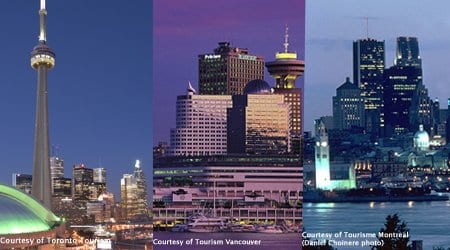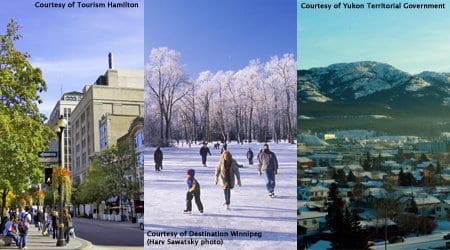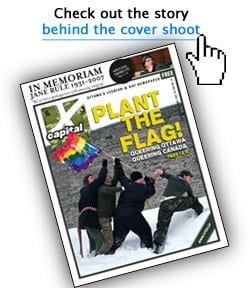On a recent business trip, a new world grabbed me by surprise. I didn’t know what to expect of the city’s gay scene but I knew I wanted to explore it.
Within the bustling metropolis I found a fetish night happening at one of the city’s three gay clubs. Artsy lesbians and bourgeois gay men strolled the streets and were in full attendance at the dance theatres and music shows. The Andy Warhol exhibit was showing at the city’s art gallery. Culture, art, culture. I left the city feeling happy and gay, refreshed after my two weeks in Winnipeg.
You read it right — The Peg. (okay, maybe bustling metropolis is a bit of an overstatement). Sometimes referred to as “Winterpeg” and home of the legendary most-freezing-street-corner of Portage and Main, Winnipeg has a gay community that is anything but cold.
Half of Canada’s same-sex couples live in just three fabulous cities: Montreal, Toronto and Vancouver, according to Statistics Canada, 2007. Now, using StatsCan’s flawed data on a flawed metric can only generate results of a limited use, but it’s the best data that’s available at the moment. And — what’s more frightening — considering that the gays-against-marriage backlash started in urban centres, it’s at least possible that our best guesses actually underestimate the number of gays that live in the big three.
The Mado drag shows of Montreal are pure gay entertainment one could not find elsewhere. The unending queer parade of Toronto Pride can’t be matched. And Vancouver’s West End is about as great as a gay village can get — anywhere in the world.
But Canada is big. Very big. And believe it or not, Canadian queer life beyond the major cities is thriving.
Because of the vast size of our nation, Canada’s homo density is far less concentrated than, say, the Greek island of Lesbos (er, for instance). Our land is vast, and so is the distribution of the gay population.
Gay up north
Winnipeg isn’t the only city with a proud contingent of lesbians and gays staking a claim to the place where they live.
As the most western Canadian city, and with a population of roughly 25,000, Whitehorse, Yukon, is isolated and small. But the gay community in Whitehorse is booming, according to Stephen Dunbar-Edge, president of Gay and Lesbian Alliance Yukon. Dunbar-Edge grew up in Whitehorse and loves how “open and accepting” the city is.
Dunbar-Edge and his husband were the first gay couple to marry in the Yukon, and he has two daughters with a lesbian couple. He says their families are accepted in the Whitehorse community.
“In Whitehorse, the gay community is so integrated. People focus more on connection with the community,” says Dunbar-Edge.
Oh and there’s a twist: the high lesbian-to-gay-man ratio in Whitehorse.
“Lesbians outnumber gay men by about 20:1, he says. “No joke — 20:1.”
I was shocked, and then momentarily pictured myself trucking up to Whitehorse with a U-Haul like a true lesbian — “Uh, hi. I’m Sarah. I heard there were lots of dykes here?” Back to reality.
There is little quantitative data to support this ratio, but Dunbar-Edge’s impressions come from spending his life in the city. He attributed the high number of lesbians in Whitehorse to the commonalities in what lesbians want in terms lifestyle.
“The [gay] women want to grow in their profession but also want a lifestyle that doesn’t tax their well-being. Whitehorse is a place where they can do that. There is nature, animals, and serenity. Gay men tend to be more drawn to urban centres, where they find acceptance, shopping, and more men.”
He also points to the stereotype of the outdoorsy lesbians who prefer country living. Whitehorse: definitely country living.
Gay community members of Whitehorse meet each other through social networks and activities. For example, Whitewater Wednesdays in Whitehorse is a weekly social music event that attracts many gays. Friends meet friends meet friends and so on.
“From the perspective of acceptance, living your life, and participating in the community, Whitehorse is my favourite gay place in Canada. But if it’s go-go boys dancing on a bar you want — you won’t find it in Whitehorse!”
Ask the Queer Geographer
Brian Ray is a professor of social geography at the University of Ottawa. His research interests include studying the geographies of gender and sexuality.
Ray cited Nova Scotia as being an important gay region in Canada due to the high density of universities. This province with a population of one million has 11 universities and 13 community colleges.
“Not only do universities tend to be more open and accepting places, but they have more laws on employment and discrimination. They are so rule-driven.”
Minority group members employed by universities have excellent systems in place to deal with any discrimination that may occur. This draws mobile queers to the institutions.
But also, smaller cities that have seen tough economic times often have strong gay communities.
“St John’s, Winnipeg and Hamilton are not looked upon as being economic growth machines. The experience of economic hardship makes them thinks about the resources in their community.”
People will turn to their community after events like job losses and shifting from full-time to part-time work. Ray also notes the correlation between arts scenes and gay communities, citing Winnipeg and St John’s as examples.
And Hamilton?
Hamilton has a tightly knit gay community and a long-running, centrally located gay bar, The Embassy, which draws queers from smaller Southern Ontario towns. It’s on the cusp of big-citydom, but being only an hour from Toronto, there’s always the temptation of weekend fleeing for a bigger party scene.
Churches in Hamilton advertise that they perform gay marriages, and Hamilton’s 2007 Pride events included an art crawl, a picnic, symposia, plays, book readings, plus the parade and afterparty.
And queer Hamilton residents have a community centre, not bad eh?
But Hamilton has half a million people. In some regions, especially in small towns, queers do not have gay bars let alone niche groups like a lesbian smoking cessation support or gay golfing society.
Ray cites research about how queers meet, including bookstores with a diverse range of subject matter, alternative cafés, and also at cruising spaces like parks, recreation facilities, street cruising using subtle signals, word of mouth and increasingly, the internet.
After Montreal, Toronto and Vancouver, Ray chose Winnipeg, St John’s, and “in a strange way, Ottawa,” as the gayest cities in Canada.
“Ottawa is a place where there is a significant gay community. And that’s partly because of the nature of the work [there]. But the community is much larger than you would expect, given the number of people.” He compares it to Portland, Oregon, a city of a similar size but with a gay community that is much more visible.
Ray attributes Ottawa’s lack of visibility to the social conservatism in the city. “Ottawa is not wildly embracing of difference,” he says. “And if you look at the Ottawa Citizen or the Sun, they’re not particularly supportive [of the gay community].”
Whether you call Ottawa a big-small city, or a small-big city, it lacks the eccentric, over-the-top Montreal gay vibe.
But Ottawa has a lot to cheer about. Queer theatre, literary and film events are on the rise. Ottawa presents a unique opportunity of combining grassroots community with a big city flavour. The launch of a gay village initiative seems to be gaining traction.
With the right attitude, the gay in Ottawa — and other smaller cities across Canada — can be uncovered.



 Why you can trust Xtra
Why you can trust Xtra


